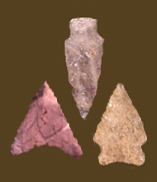|
BREWERTON CORNER NOTCHED
Defining Attributes

The Brewerton Corner Notched is a medium-sized, broad and thick point, with wide shoulders and pronounced corner notching.
.jpg)
Chronology
The Brewerton Corner Notched point is part of the Brewerton Complex, which began during the late Middle Archaic period and continued into the Late Archaic. There are few direct radiocarbon dates on the Brewerton Corner Notched, but the age of the Brewerton Complex has been determined from dates on the other Brewerton types. Most authorities feel the four point types of the Brewerton Complex were contemporary, although Ritchie (1971) suggests the Side Notched was the oldest. Custer (1996b) places the start of the Brewerton Complex around 4300 BC (calendar) and continuing to perhaps 1600 BC. Justice (1987) suggests a range of 4930 to 3673 BP (approximately 3700-2050 BC calendar), while Funk (1993) suggests 5150 to 4450 BP (approximately 3950-3100 BC calendar) for the Brewerton Complex in the Upper Susquehanna Valley.
Description
Blade: The blade is triangular, and biconvex to flat in cross section. Edges are generally slightly excurvate, but can be straight or incurvate.
Haft Element: The stem has medium-to-large corner notches that form pronounced barbs. The expanded base is usually straight or slightly convex, but can be slightly concave. Basal grinding is common.
Size: Length ranges from 24 to 79 mm, with most between 32 and 57 mm. Width ranges from 21 to 34 mm, with an average of 25 mm. Thickness ranges from 5 to 9.5 mm, with most around 8 mm.
Technique of manufacture: Made by percussion flaking.
Material: In a sample of 24 Brewerton Corner Notched points from the lower Patuxent drainage, Steponaitis (1980) reported that 30% were rhyolite, followed by quartz (25%), jasper (25%), quartzite (12%), and chert (8%). In the area surrounding Zekiah Swamp on the lower Potomac, Wanser (1982) found that 54% of 102 Brewerton Corner Notched points were quartz, with 24% quartzite, 15% rhyolite, 4% chert, 1% jasper, and 2% other materials. All six Brewerton Corner Notched points recorded during the Monocacy River drainage survey were rhyolite (Kavanagh 1982).
Discussion
Brewerton Corner Notched points are found across the Northeast from southern New England to Maryland, and west into the Ohio Valley (Justice 1987). They are a minority type in the Brewerton Complex (Ritchie 1971). Ritchie (1971) notes a chronological and morphological overlap between the Brewerton Corner Notched and the Vosburg point, with the latter generally having a shorter stem, smaller notches, and weaker barbs. Justice (1987) considers the Brewerton Side Notched to be a re-sharpening variant of the Brewerton Corner Notched.
Defined in Literature
Ritchie first described this type in 1940, and published a formal definition in 1961 (revised 1971).
References
Custer 1996b;
Funk 1993;
Justice 1987; Kavanagh 1982; Ritchie 1971; Steponaitis 1980; Wanser 1982 |

![]()



